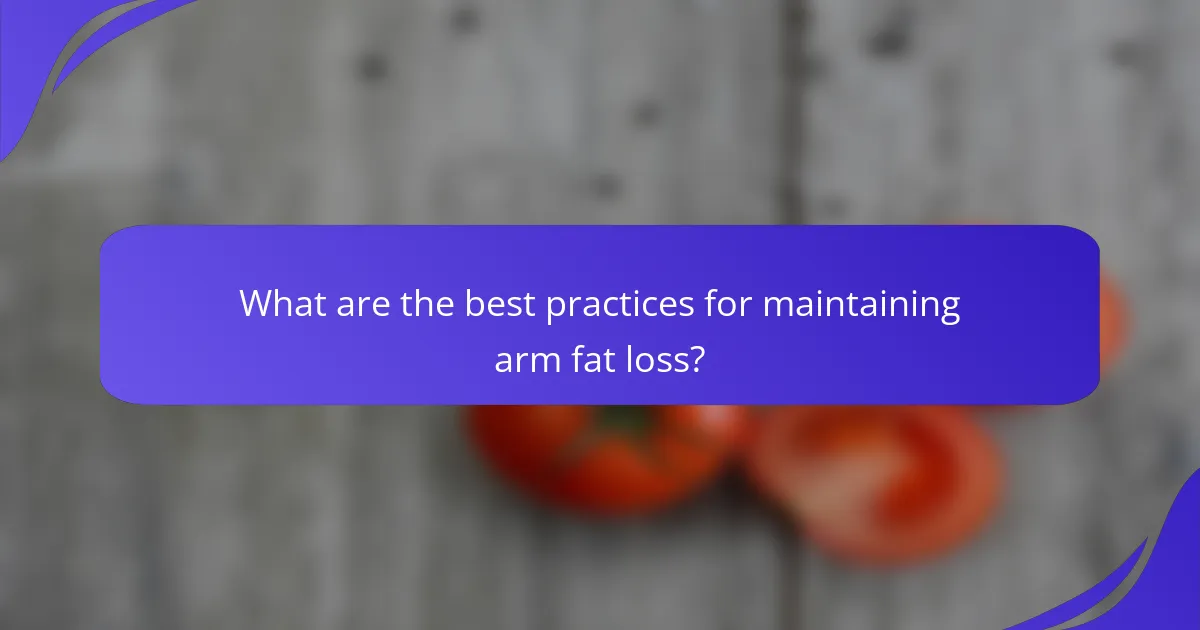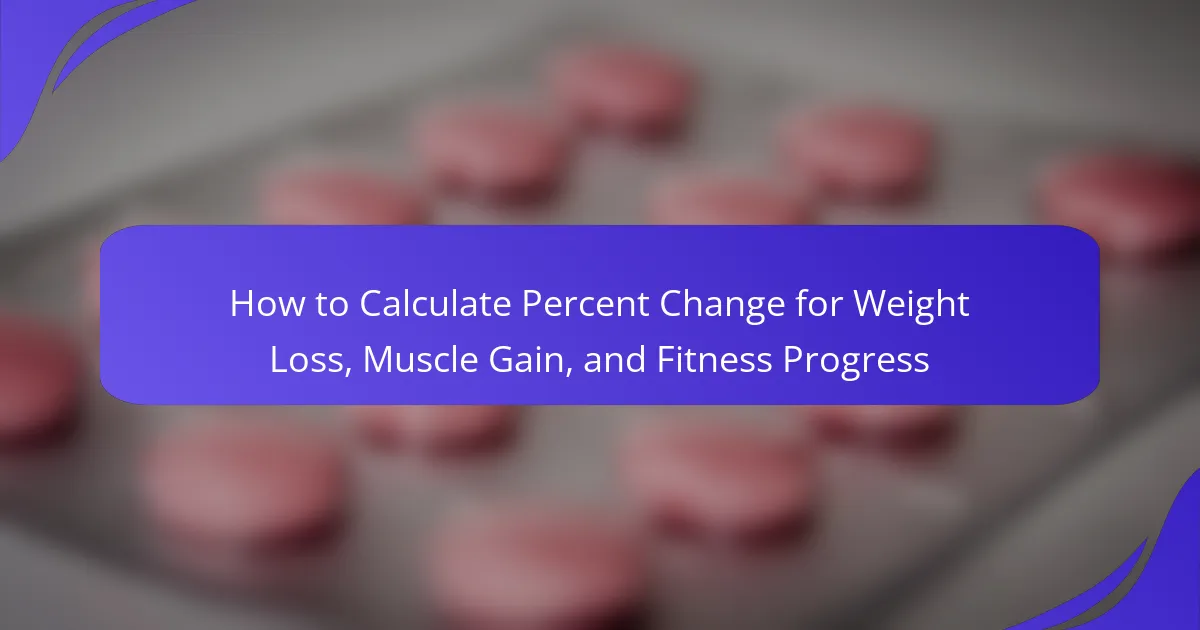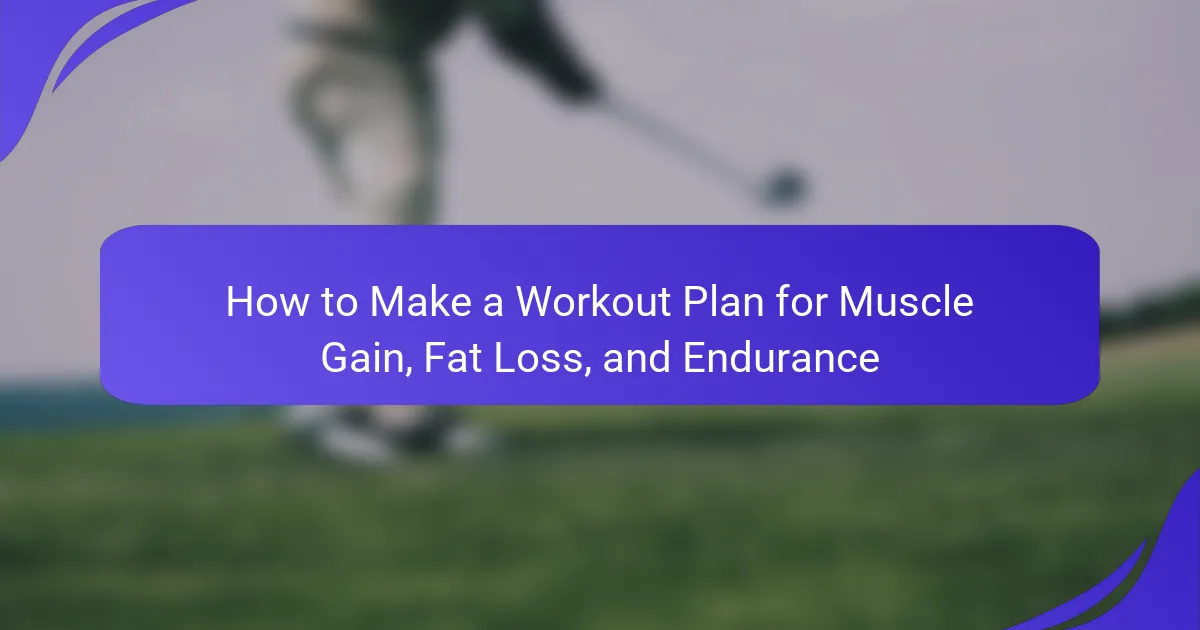Losing arm fat can be challenging, but effective workouts and nutrition strategies can help. Focus on strength training exercises like push-ups and tricep dips, combined with high-intensity interval training for optimal fat loss. A balanced diet rich in protein and healthy fats supports muscle growth and metabolism. Consistency in workouts and proper hydration are essential for achieving lasting results.

What are the most effective workouts for losing arm fat?
The most effective workouts for losing arm fat include strength training and cardiovascular exercises. Incorporate push-ups, tricep dips, and resistance band exercises to target arm muscles. High-intensity interval training (HIIT) can enhance fat loss overall. Consistency and proper nutrition are crucial for optimal results.
Which exercises target arm fat specifically?
Strength training exercises effectively target arm fat. Focus on push-ups, tricep dips, bicep curls, and overhead presses. These workouts build muscle, increase metabolism, and promote fat loss. Incorporate resistance bands for added intensity. Aim for at least three sessions per week for optimal results.
How to perform push-ups for optimal results?
To perform push-ups for optimal results, focus on proper form and gradual progression. Start with hands shoulder-width apart, body straight, and lower yourself until your chest nearly touches the ground. Push back up to the starting position. Aim for controlled movements to engage arm muscles effectively. Incorporate variations like incline or decline push-ups to target different muscle groups. Consistency in practice enhances strength and reduces arm fat over time.
What is the role of tricep dips in arm fat loss?
Tricep dips play a significant role in arm fat loss by targeting the triceps, which are essential for overall arm definition. These exercises enhance muscle tone and promote fat burning through increased metabolism. Regularly incorporating tricep dips into a workout routine can lead to improved arm strength and reduced fat, especially when combined with a balanced diet. Engaging multiple muscle groups during this exercise maximizes calorie expenditure, making it a unique strategy for effective arm fat loss.
How can resistance bands help in toning arms?
Resistance bands effectively tone arms by providing resistance during workouts, enhancing muscle engagement. They allow for a variety of exercises targeting biceps, triceps, and shoulders, promoting muscle growth and fat loss. Resistance bands are portable and versatile, making them ideal for home workouts. Studies show that incorporating resistance bands can lead to increased strength and improved muscle definition over time.
What is the importance of compound movements?
Compound movements are crucial for losing arm fat as they engage multiple muscle groups, enhancing calorie burn and muscle growth. These exercises, such as push-ups and pull-ups, stimulate the arms while also working the chest, back, and core. This multi-muscle engagement leads to more efficient workouts and improved metabolic rates. Incorporating compound movements into your routine can result in faster fat loss and increased overall strength.
How often should workouts be performed for best results?
Workouts should be performed 3 to 5 times a week for optimal results in losing arm fat. Consistency is key to achieving significant fat loss and muscle toning. Studies indicate that a combination of resistance training and cardio enhances effectiveness. Aim for at least 150 minutes of moderate exercise weekly, integrating strength training for arms twice a week. This balanced approach maximizes fat loss while building lean muscle.

What nutritional strategies support arm fat loss?
To support arm fat loss, focus on a balanced diet rich in protein, healthy fats, and fiber. Incorporate foods like lean meats, nuts, and vegetables to boost metabolism and promote muscle growth. Maintain a calorie deficit while ensuring adequate hydration and nutrient intake. As a result, this approach enhances fat loss specifically in the arms.
Which foods are best for reducing body fat?
Foods that help reduce body fat include lean proteins, whole grains, fruits, and vegetables. Lean proteins like chicken and fish promote muscle growth, aiding fat loss. Whole grains provide sustained energy and fiber, which supports digestion. Fruits and vegetables are low in calories and high in nutrients, helping to control hunger. Incorporating healthy fats from sources like avocados and nuts also contributes to satiety and overall health.
What role does protein play in muscle toning?
Protein is essential for muscle toning as it aids in muscle repair and growth. Consuming adequate protein supports muscle synthesis, which is crucial for achieving toned arms. Research indicates that a higher protein intake can enhance muscle recovery and improve workout effectiveness. Aim for approximately 1.2 to 2.0 grams of protein per kilogram of body weight daily for optimal results.
How can hydration impact fat loss?
Hydration significantly impacts fat loss by enhancing metabolic processes and reducing appetite. Adequate water intake boosts energy levels, promoting more effective workouts. Studies show that drinking water before meals can decrease calorie intake, aiding weight management. Additionally, staying hydrated improves overall body function, facilitating fat oxidation.
What are the common dietary mistakes to avoid?
To lose arm fat effectively, avoid common dietary mistakes like skipping meals, consuming too many processed foods, and neglecting protein intake. These errors can hinder fat loss and muscle development. Prioritize whole foods, maintain balanced meals, and ensure adequate hydration.

What unique strategies enhance arm fat loss?
Incorporating unique strategies can significantly enhance arm fat loss. Focus on high-intensity interval training (HIIT) to maximize calorie burn and boost metabolism. Integrate strength training targeting the arms, such as tricep dips and push-ups, to build muscle and promote fat loss.
Nutrition plays a critical role; prioritize protein-rich foods to support muscle growth and recovery. Monitor caloric intake and opt for whole foods to reduce body fat effectively. Hydration is essential; drink sufficient water to aid metabolic processes and reduce cravings.
Consistency is key; establish a regular workout routine and stick to it. Tracking progress through measurements or photos can provide motivation and accountability.
How does strength training differ from cardio for arm fat reduction?
Strength training effectively reduces arm fat by building muscle, while cardio primarily burns calories. Strength training increases metabolic rate, promoting fat loss over time. Cardio enhances cardiovascular health but may not specifically target arm fat. Combining both methods yields optimal results for arm fat reduction.
What is the significance of rest days in a workout regimen?
Rest days are crucial in a workout regimen as they allow muscles to recover and grow stronger. Adequate rest prevents injury and enhances performance, ensuring sustainable progress in losing arm fat. Incorporating rest days can improve overall workout effectiveness by balancing exertion and recovery. Aim for at least one rest day per week to optimize results and maintain motivation.

What rare tips can accelerate arm fat loss?
Incorporating unique strategies can significantly enhance arm fat loss. Focus on high-intensity interval training (HIIT) to maximize calorie burn and preserve muscle. Integrate resistance training with compound movements like push-ups and tricep dips, which engage multiple muscle groups. Prioritize protein-rich foods to support muscle recovery and increase satiety. Utilize hydration as a tool; drinking water before meals can reduce overall calorie intake. Lastly, ensure adequate sleep, as it plays a crucial role in weight management and recovery.
How can interval training be incorporated effectively?
Interval training can be effectively incorporated by alternating high-intensity exercises with rest or low-intensity periods. This method boosts metabolism and enhances fat loss, particularly in the arms. Start with short intervals, gradually increasing intensity and duration. For optimal results, combine interval training with strength exercises targeting the arms, ensuring a balanced approach to fat loss. Consistency is key; aim for at least three sessions per week to see significant improvements.
What role does sleep play in fat loss?
Sleep significantly impacts fat loss by regulating hormones that control appetite and metabolism. Adequate sleep enhances recovery, promotes muscle growth, and reduces cravings, making it easier to maintain a calorie deficit. Studies show that insufficient sleep can lead to weight gain due to increased ghrelin levels and decreased leptin levels. Prioritizing quality sleep can thus support effective fat loss strategies for men targeting arm fat.

What common mistakes hinder arm fat loss progress?
Common mistakes that hinder arm fat loss progress include neglecting nutrition, overtraining without rest, and focusing solely on arm exercises. Many individuals underestimate the importance of a balanced diet, which plays a crucial role in fat loss. As a result, consuming excessive calories or unhealthy foods can stall progress. Additionally, failing to allow adequate recovery time can lead to fatigue and decreased workout effectiveness. Lastly, concentrating only on arm workouts without incorporating full-body exercises limits overall fat loss potential.
How to avoid plateaus in arm fat loss?
To avoid plateaus in arm fat loss, incorporate varied workouts, adjust nutrition, and track progress. Change your exercise routine every few weeks to challenge muscles. Include both strength training and cardiovascular exercises for optimal results. Ensure a caloric deficit by adjusting your diet, focusing on protein intake to support muscle maintenance. Regularly monitor your progress and make necessary adjustments to your routine for continued fat loss.
What are the signs of overtraining?
Overtraining can manifest through several signs, including persistent fatigue, decreased performance, and increased irritability. Other indicators are insomnia, muscle soreness that lasts longer than usual, and frequent injuries. Monitoring these symptoms is crucial to maintaining effective workouts and overall health.

What are the best practices for maintaining arm fat loss?
To maintain arm fat loss, focus on a combination of consistent workouts, balanced nutrition, and lifestyle changes. Incorporate strength training exercises targeting the arms, such as push-ups and tricep dips, at least three times a week. Pair this with cardiovascular activities to enhance fat burning.
Monitor your caloric intake by choosing nutrient-dense foods, including lean proteins, whole grains, and plenty of fruits and vegetables. Staying hydrated is crucial; aim for at least eight glasses of water daily.
Additionally, prioritize sleep and manage stress, as both can impact weight management. Consistency is key; track your progress to stay motivated and make adjustments as needed.
How to create a sustainable workout routine?
To create a sustainable workout routine, focus on consistency, variety, and enjoyment. Start with a schedule that fits your lifestyle, committing to regular sessions. Incorporate strength training, cardio, and flexibility exercises to target arm fat effectively. Gradually increase intensity to avoid burnout. Nutrition plays a crucial role; prioritize lean proteins, healthy fats, and ample hydration. Set realistic goals and track progress to maintain motivation. Engage in activities you enjoy to ensure long-term adherence.
What lifestyle changes support long-term results?
To achieve long-term results in losing arm fat, incorporate sustainable lifestyle changes. Focus on a balanced diet rich in lean proteins, vegetables, and healthy fats. Regular strength training, particularly targeting the arms, enhances muscle tone and fat loss. Consistent cardiovascular exercise supports overall weight management. Prioritize hydration and adequate sleep to optimize recovery and metabolism. Making gradual changes ensures adherence and effectiveness, leading to lasting results.



